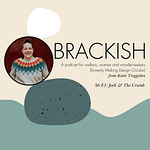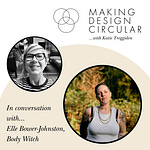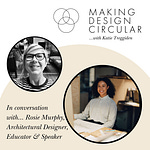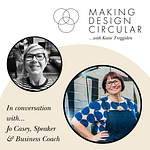Is there a trade-off between affordability and disposability? Can we go back to a mindset of mending and repair, without pricing ourselves out? How do we overcome the objections of time, money and skillset to get more people involved in this movement?
On today’s episode, I’m talking to Tom van Deijnen – a self-taught textiles practitioner, founder of The Visible Mending Programme, and a volunteer at the Brighton Repair Café. He says that he likes ‘doing things that take forever’ because that slow pace gives him a deeper understanding of material qualities and traditional techniques.
We discuss:
- Why visibility in mending is important.
- How wearing mended clothes still has associations with poverty for some people.
- His time with Brighton Repair Café and its values and purpose.
- Why mindset shifts are important as we try to move towards a more circular economy.
… and more!
Here are some highlights.
What interests him in the visibility of the mend
“Originally, I was of the very traditional mindset of, ‘Oh, if I repair something, it needs to be invisible, nobody should be allowed to see it.’ It turns out that it is really, really difficult to repair something invisibly! It's just very, very difficult to do that. So I was thinking, if you can kind of see it anyway, then just turn it into a feature and let's not try and hide the fact that it’s mended. I started changing my mind a bit about that, and then I started to enjoy adding something visible and highlighting the fact that my items have been worn. I love the patina of use anyway. I buy shoes that I really like, but I only find them really beautiful once I've worn them in and you get all the nice creases in the leather, that's when I find my shoes most beautiful or my bag or what have you. I enjoy seeing the patina of use and lots of people, for instance, with denim, they wanna see that used look. In fact, you can buy jeans pre-distressed. Obviously, there's a big interest in that. And for me, it's also a way of showing that I care about this item, highlighting the history of it. It's sometimes a conversation starter. I'm not gonna shout “you must mend,” but if somebody asks me, “Oh, I see you've got this patch on there, what's that all about?’ Then I'll explain that I like to look after my clothes and make them last for longer, and this is why I do it. Look, we've had a conversation about it now, maybe if you fancy it, give it a go yourself.”
The popularity of the visible mending movement on social media
“It's great to see. I really like seeing other people's repairs, and I really like the social aspect of social media. The Internet has really allowed people to come together from all over the world, and that's something that I really enjoy. I've met quite a few people through that. People I would never have met otherwise, and yeah, so you start sharing ideas and hear about how people in their own country or their own family look at these things and what they might do and not do, or how they view repairs. Yeah, I find it really interesting and it's very nice to see that so many people have embraced it.”
The importance of understanding how things are made
“I think it's important to realize when I say we should go back to an older mindset, I'm not saying we necessarily need to raise prices, it's more about the way that people would treat these items that I think we should go back to. And the other thing that people often confuse is price versus ethical production. You might spend a lot of money on designer clothes, but that doesn't mean that they have been produced more ethically than a t-shirt from H&M or Next, they can be made even in the same factory, there will just be given higher quality materials to sew with, and they are allowed to spend more time putting it together or use different techniques that are a bit more expensive to use. I think for me, that means even if you did only spend five pounds on a t-shirt because that's what you can afford, try to look at it as if you have spent two weeks worth of wages or a month of wages on it, so you look after it. And I think it is really difficult for people to understand. All clothes are made by hand. They are made by people.”
Amy Twigger Holyroyd's book Folk Fashion in which she talks about open and closed objects/systems/structures: https://amytwiggerholroyd.com/Folk-Fashion
IPCC Sixth Assessment Report: https://www.ipcc.ch/report/ar6/wg1/
Connect with Tom van Deijnen here.
Follow Tom on Instagram here.
About Katie Treggiden
Katie Treggiden is a purpose-driven journalist, author, podcaster and keynote speaker championing a circular approach to design – because Planet Earth needs better stories. With 20 years' experience in the creative industries, she regularly contributes to publications such as The Guardian, Crafts Magazine, Design Milk and Monocle24. Following research during her recent Masters at the University of Oxford, she is currently exploring the question ‘can craft save the world?’ through an emerging body of work that includes her fifth book, Wasted: When Trash Becomes Treasure (Ludion, 2020), and this podcast.
You can find Katie on Instagram @katietreggiden.1, sign up for her e-newsletter here and if you’re a designer-maker interested in becoming more sustainable, sign up for her free Facebook Group here . If you’d like to support more fantastic content like this, you can buy Katie a ‘virtual coffee’ here in exchange for behind the scenes content and a shout-out in Season Three.














Share this post